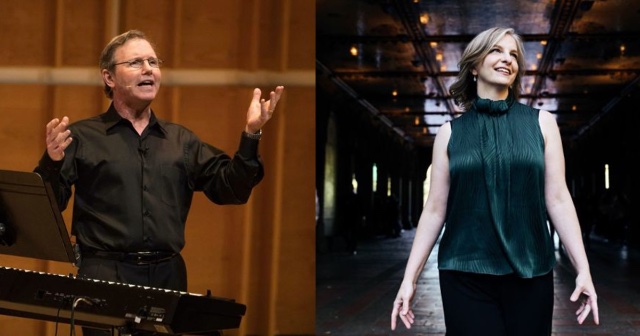Rob Kapilow Tackles the Appassionata Sonata
Orli Shaham Exposes a Sonata
By: Susan Hall - Sep 27, 2020
Kaufman Music Center presents
What Makes It Great?
Beethoven, the Pandemic & the Power of Connection The Appassionata Sonata
Rob Kapilow, commentator and conductor
Orli Shaham, piano
Rob Kapilow begins his “What Makes it Great” evenings with a discussion of special elements in a musical work to be performed in its entirety at the conclusion of the evening. Kapilow is a conductor and performer. For those being introduced to him for the first time, note he is a concert caliber pianist who studied conducting with Nadia Boulanger in a break he took from his Yale undergraduate course before breaking was fashionable. He returned to earn a Summa Cum Laude degree.
Always responsive to a live audience, he draws us in, elucidating us as he instructs. Now he is streaming from an empty Merkin Hall. Yet you become addicted in one outing. Through Kapilow, listening to music has added whole new dimensions.
Rob Kapilow has an idea about the well-known Beethoven Piano Sonata No.5, which we would never call familiar, although we instantly recognize the arpeggios, the pedaled blurs and the leaps and bounds which extend the listening ear and heart. This work, for Kapilow, is about connection. It is what we are missing in this time of Covid. Through the composer, the conductor and the pianist, we can still find connection in great musical performance.
Like the humble opening of the ‘Appassionata’ sonata, which is repeated in the final movement, Kaplilow treats us with respect and concern as he presents in a way his audience can understand without dumbing down. This Kapilow does in spades, accompanying himself, or calling on the pianist.
Kapilow partnered with the wonderful pianist, Orli Shaham. They have worked together in the past, and clearly connect. To illustrate the radical new ideas Beethoven expressed, Shaham must display the essence of poetry in music and also torrential sound rages. She captures both ends of this impossible spectrum with seeming ease. Miraculous.
At the opening, we hear mystery in Shaham’s hands. Silences are suggestive. Unexpected harmonies bump up. Sound holes spread between the left and right hands. A kinetic explosion is repeated over a throbbing base. All these possibilities are miraculously brought out by Shaham. Her contemplative take on the second movement ends in surprising drama.
Shaham conveys the sense, as she performs the entire work, that there is nothing else in the world happening in these moments. Single notes are not brought out. We are deep in the mind’s ear. Only watching her fingers, do we see that a soul is going through expiring gradations.
Often an F at the bottom of the keyboard, the lowest note available in Beethoven’s time, is furiously repeated. He might have gone lower on an 88 keyboard which starts on an A. Other pianos with 97 keys extend down to C. Beethoven surely would have appreciated this extension of possibility. Recently Stuart & Sons built a piano with 9 octaves or 108 keys. Beethoven must be smiling. He certainly would have appreciated this evening as listeners do.

